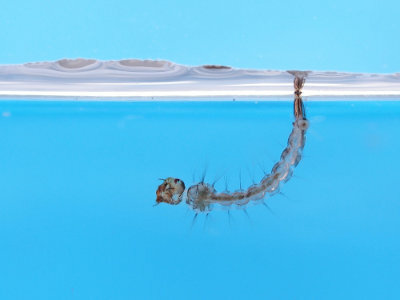O Aedes aegyptiis popularly known as gnat.dengue, despite transmitting other diseases, such as yellow fever, a chikungunya and the Zika. It has a fast development, taking about ten days to reach the adult stage after the egg hatches.
See below the main phases of the life cycle of the Aedes aegypti:
→ Egg
the life cycle of Aedes aegypti it starts after the laying of eggs by a female on the wall of a breeding site with water (the eggs are not in the water, but very close to it). These eggs are 0.4 mm long and white in color, but over time, due to contact with oxygen, they become dark.
Eggs can remain unhatched for a long period of time, waiting until the next rainy season. Studies suggest that eggs from THE. aegypti resist for up to 450 days as they are extremely resistant to drying. Egg hatching occurs when water comes into contact with this structure.
→ Larva

the larva of Aedes aegypti represents an aquatic phase of the life cycle
After the egg hatches, the THE. aegypti it becomes a larva, which is made up of the head, thorax and abdomen, the latter being formed by eight segments. During the larval stage, the
Aedes feeds mainly on organic matter present in the breeding and stands out for having great agility.The larva goes through four stages until it becomes a pupa. Under favorable conditions, with food and temperature between 25°C and 29°C, the period between hatching and pupation is around five days.
→ Pupa
The pupa stage stands out for the lack of food and for the metamorphosis that will mark the beginning of the adult stage. During the pupa stage, the THE. aegypti it has a body divided into cephalothorax and abdomen, a structure that resembles a comma. This period lasts an average of three days and, during this time, the pupa remains on the surface of the water to facilitate flight as an adult.
→ Adult
The adult stage is the best known by the population, since it is the stage in which the Aedes Aegypti it can transmit diseases to man. The mosquito, at this time, has daytime habits and a characteristic color pattern, with white stripes and spots on a black body. This color is essential for camouflaging, since it is found in dark environments and close to the ground.
A few days after the beginning of the adult phase, the mosquito is already ready for mating, which normally takes place during flight. After copulation, the female needs blood to complete the development of eggs and it is at this time that the transmission of diseases to humans can occur;
After approximately three days of ingestion of the blood, the female THE. aegypti is ready to lay eggs. These eggs are distributed to several breeding sites, most often in the late afternoon. During its lifetime, a female can give rise to approximately 1500 mosquitoes.
By Ma. Vanessa dos Santos
Source: Brazil School - https://brasilescola.uol.com.br/animais/ciclo-vida-aedes-aegypti.htm

